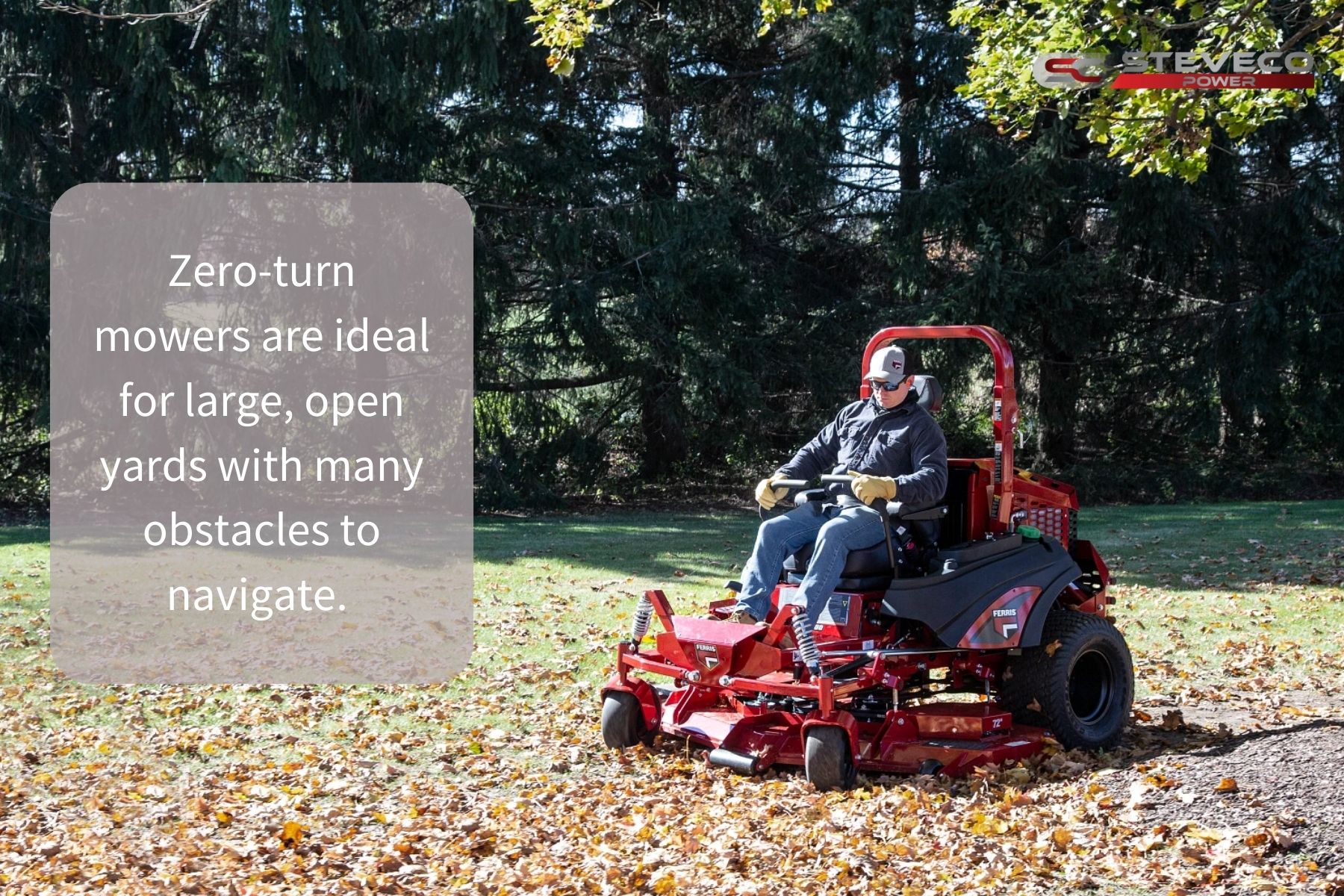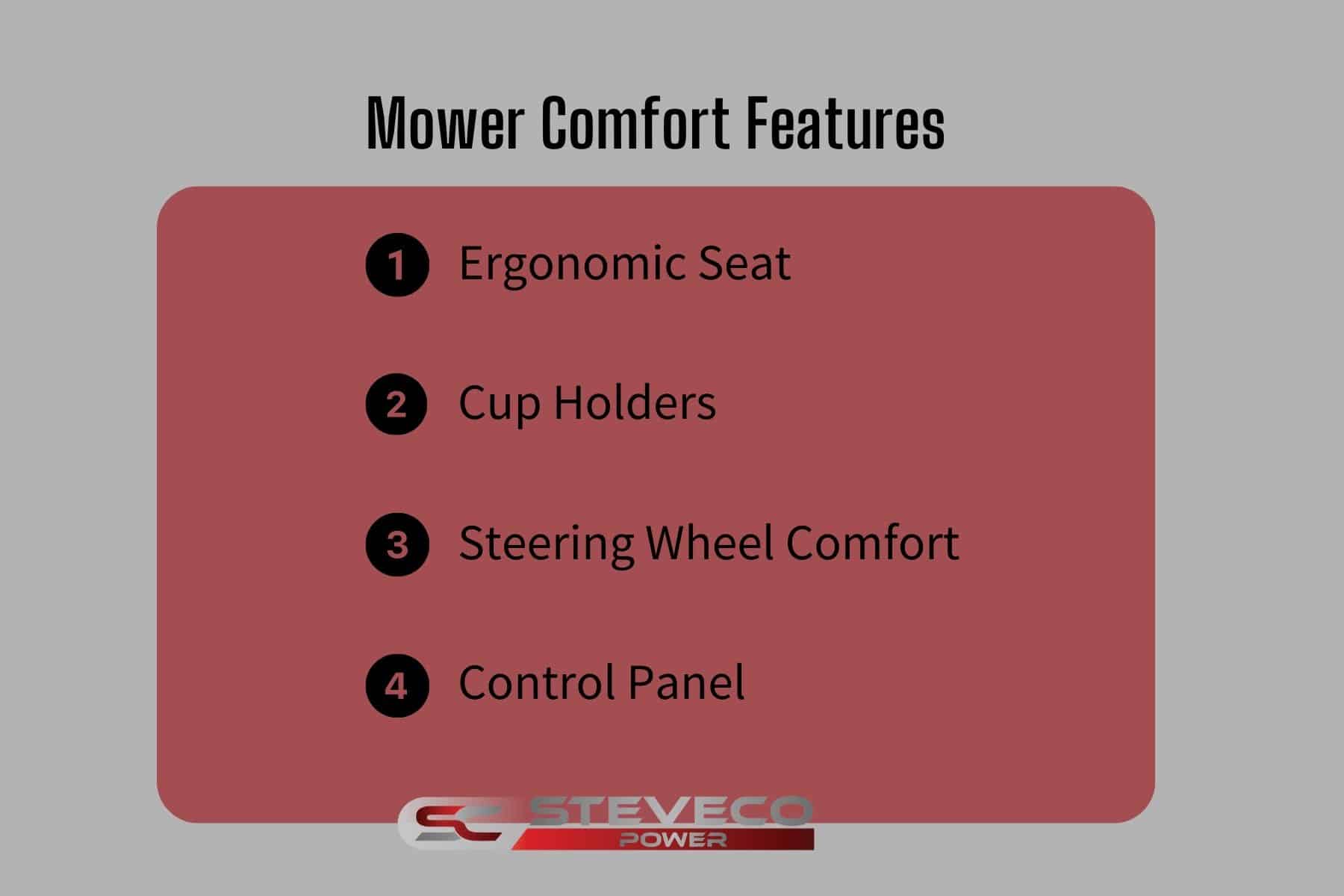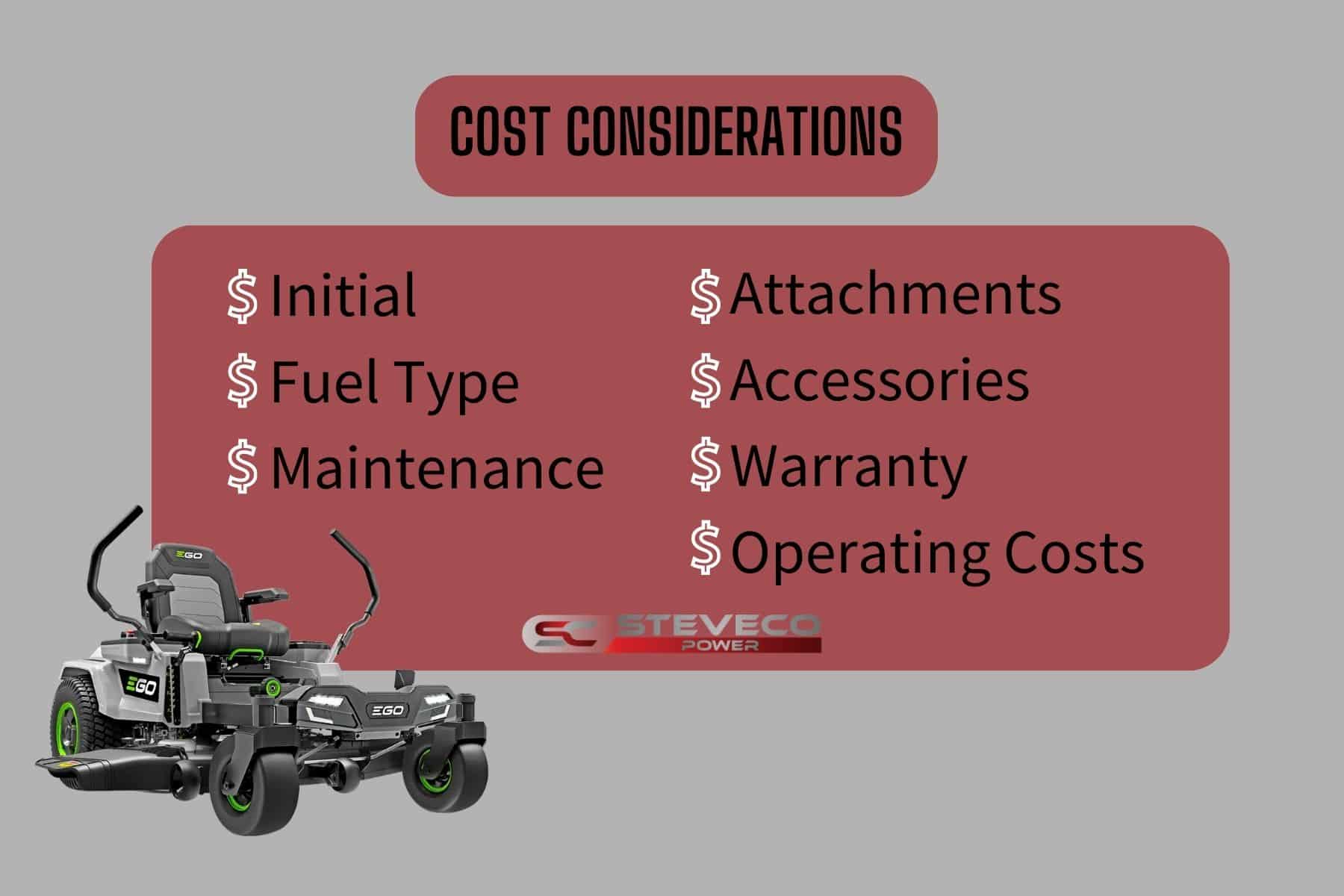A Beginner's Guide to Riding Mowers
In the world of lawn care, the choice between pushing a traditional walk-behind mower and gliding effortlessly atop a riding mower can make a world of difference.
You know this. That's why you're looking into buying a new mower. Choosing the right riding mower, however, can feel like an overwhelming task if you're just starting out.
That's why at SteveCo Power, we've put together a beginner's guide to riding mowers. We want to give you all the information you need to make the best choice for your circumstances.
At its core, a riding mower is a motorized lawn-cutting machine crafted to make the chore of mowing your yard easier and quicker. But let's not stop at the basics—this guide will delve deeper into the world of riding mowers.
Are you ready?
Let's begin by precisely defining what a riding mower is and how it differs from small tractors.
What Is a Riding Mower?
A riding mower, in essence, is a motorized lawn-cutting machine engineered to enhance the efficiency of mowing your yard. Unlike traditional walk-behind mowers, a riding mower allows you to comfortably sit or stand atop the machine while steering it across your lawn. This reduces the physical effort required for the task.
Riding mowers are more akin to dedicated lawnmowers than small tractors used in farming or heavy-duty landscaping. They are tailored for residential lawn care needs, offering a user-friendly, time-saving alternative for homeowners and beginner lawn care enthusiasts looking to upgrade their mowing experience.
Different Styles of Riding Mowers
When it comes to choosing the right riding mower, understanding the various styles available is essential. These styles cater to different needs and preferences, so let's explore each one in detail to help you make an informed decision.
1. Ride-On Mower:
Overview: Ride-on mowers are the most common and versatile type of riding mower. They are characterized by a comfortable seat for the operator, a steering wheel or handlebars for control, and a cutting deck beneath.
Ideal Use: Ride-on mowers work well for medium to large yards with relatively flat terrain. They are excellent for straightforward mowing tasks and are user-friendly, making them a great choice for beginners.
2. Lawn Tractor:
Overview: Lawn tractors are similar to ride-on mowers but offer extra versatility. In addition to mowing, they often come with attachments for tasks like snow removal, hauling, or garden tilling.
Ideal Use: Lawn tractors are perfect for those who need a multi-purpose machine. If you want a mower that can handle additional yard tasks, a lawn tractor is a smart choice.
3. Zero-Turn Mower:
Overview: Zero-turn mowers are known for their exceptional maneuverability. They have rear-wheel motors that enable a zero-degree turning radius, allowing you to pivot on the spot.
Ideal Use: Zero-turn mowers are ideal for large, open yards with many obstacles to navigate. They're efficient and provide a precise cut, but they may require a bit of practice to master their maneuverability.

4. Rear-Engine Riding Mower:
Overview: Rear-engine riding mowers are smaller and more compact than other styles. They have the engine at the back and a cutting deck in the front.
Ideal Use: These mowers are great for smaller yards with tight spaces or homeowners who have limited storage for their mowers. They are less powerful than larger models but are easy to operate and maintain.
5. Stand-on Mower:
Overview: Stand-on mowers are unique because the operator stands on a platform rather than sitting. This design provides better visibility and agility and keeps the operator feeling better after a few hours of mowing the lawn.
Ideal Use: Stand-on mowers are suitable for professionals or homeowners with larger properties. They offer efficiency and maneuverability and are a good choice if you have a lot of intricate landscaping to navigate.
To reiterate, the choice of a riding mower style depends on your specific needs and the characteristics of your yard. If you have a relatively simple lawn and want a comfortable, easy-to-use option, a ride-on mower is a solid choice. For those who require versatility, a lawn tractor can handle more than just mowing. Zero-turn mowers excel in speed and precision for larger, obstacle-filled yards. If you have limited space, a rear-engine riding mower is compact and efficient. Lastly, stand-on mowers are a favorite of professionals or those with intricate landscapes to maintain.
Remember to consider the size of your yard, the terrain, and any additional tasks you want your riding mower to perform when making your decision. Each style has its advantages, so assess your needs and choose the one that aligns best with your lawn care goals.
Mower Features
When you're in the market for a riding mower, the array of features and options can be overwhelming. What attachments do you need? Should you opt for electric or gas? How about brakes, suspension, and comfort features? Fear not; at SteveCo Power, we're here to simplify it all for you.
Attachments: Enhancing Functionality
Attachments are like the Swiss Army knife of riding mowers. They allow you to customize your mower to suit specific lawn care tasks. Here are some key attachments to consider:
- Baggers: Ideal for collecting grass clippings and leaves, baggers keep your lawn neat and save you from raking.
- Mulching Kits: These attachments finely chop grass clippings and disperse them back into your lawn, nourishing it with natural nutrients.
- Snow Blades: If you live in snowy regions, a snow-blade attachment transforms your mower into a snow removal machine, clearing driveways and paths.
- Tow-Behind Carts: Perfect for hauling garden tools, soil, or even firewood, these carts expand the utility of your riding mower.
- Spreaders and Sprayers: Make fertilizing and pest control a breeze with these attachments, which evenly distribute materials across your lawn.
Transmissions: Power and Control
Transmissions determine how power is delivered to the wheels, impacting your mower's performance and ease of use. There are two main types:
- Automatic: This user-friendly option simplifies mowing by eliminating the need for manual shifting. Just press the pedal to go and release to stop.
- Manual (Hydrostatic): Offering more control, manual transmissions allow you to adjust your speed smoothly, much like driving a car with a clutch.

Electric vs. Gas: Fueling Your Mower
Choosing between electric and gas-powered mowers boils down to personal preference and lawn size:
- Electric: Quiet, eco-friendly, and low maintenance, electric mowers are great for small to medium-sized lawns. They're easy to start, require less maintenance, and emit no harmful fumes.
- Gas: Gas-powered mowers are robust workhorses, perfect for larger lawns with tough grass. They offer more power and freedom of movement but require regular fueling and maintenance.
Brakes: Safety First
Brakes are a critical safety feature. Most riding mowers have foot pedals for brake and gas control. Make sure they are responsive and easy to operate, ensuring you can stop quickly when needed.
Speed: Finding the Right Pace
Riding mowers come with variable speed settings. For large, open lawns, higher speeds can save time, but slower speeds are essential for precise maneuvers around obstacles or in tight spaces.
Wheels: Traction Matters
Wheels provide traction, ensuring your mower can navigate various terrains. Consider models with wide, heavy-duty tires for enhanced stability and grip, especially if you have uneven or hilly terrain.
Suspension: Smooth Riding
Suspension systems reduce jolts and bumps, offering a smoother ride and protecting your back during longer mowing sessions. Look for mowers with adjustable suspension for added comfort.
Deck: Cutting Precision
The cutting deck houses the blades and determines the width of your mowing path. Wider decks cover more ground quickly, but narrow decks are better for navigating tight spaces. Ensure the deck is adjustable in height to customize your grass-cutting height.
Comfort Features: Mowing Bliss
To make your lawn mowing experience enjoyable, pay attention to comfort features:
- Ergonomic Seat: A well-padded, adjustable seat can make a world of difference during extended mowing sessions.
- Cup Holders: Stay hydrated without interruptions, thanks to built-in cup holders.
- Steering Wheel Comfort: An ergonomic steering wheel with a comfortable grip can reduce fatigue.
- Control Panel: A user-friendly control panel ensures easy access to essential functions while mowing.
As you explore different riding mower options, keep these features in mind to match your mower to your specific needs and make lawn care a breeze. Whether it's attachments for added functionality or comfort features for a smoother ride, understanding these essential elements will help you choose the perfect riding mower for your lawn.

Choosing a Riding Mower
If you're considering upgrading from a trusty walk-behind mower to a riding mower, you're about to experience more efficient and comfortable lawn care. However, choosing the right riding mower isn't as simple as it may seem. To help you make an informed decision, let's delve into three key considerations: maintenance, cost, and yard size.
Maintenance Considerations
One of the prime benefits of riding mowers is their convenience, but they do require some maintenance to keep them running smoothly. Here are the main maintenance aspects to consider:
- Regular Cleaning: Grass clippings and debris can accumulate under your riding mower's deck, leading to clogs and reduced cutting performance. Regularly clean the deck and undercarriage to prevent these issues.
- Oil Changes: Just like your car, a riding mower needs regular oil changes. Check your mower's manual for the recommended frequency and type of oil.
- Air Filter: Keep the air filter clean or replace it according to the manufacturer's guidelines. A clean filter ensures your engine breathes well and runs efficiently.
- Blade Maintenance: Sharpen and balance the blades or replace them as needed. Dull blades tear the grass instead of cutting it cleanly, resulting in an uneven and damaged lawn and potential damage to your mower.
- Tire Care: Maintain proper tire pressure to ensure even cutting and avoid damaging the lawn.
- Battery Maintenance: For electric start mowers, keep the battery charged and inspect the cables regularly.
- Belt and Transmission: Check the belts for wear and tension. Grease the transmission if it's not sealed.
- Fuel Management: If you have a gas-powered mower, use fresh fuel and consider using fuel stabilizers during the off-season.
Cost Considerations
Understanding the cost factors involved in purchasing and owning a riding mower is crucial to staying within your budget. Here's what you need to know:
- Initial Cost: Riding mowers come in a wide price range. Basic models start at a few thousand dollars, while high-end models can cost between ten to twenty thousand. Determine your budget before shopping to narrow down your options.
- Fuel Type: Gas-powered mowers are common and often less expensive than electric models, but consider the fuel costs over time. Electric mowers are more eco-friendly and quieter but may cost more upfront.
- Maintenance Costs: Factor in ongoing maintenance expenses, including oil changes, blade replacements, and repairs. High-end models may have higher maintenance costs but likely require it less often.
- Attachments and Accessories: Riding mowers often offer various attachments like baggers, mulchers, and snowplows. These can add to your overall cost but may enhance your mower's versatility.
- Warranty: Consider the length and coverage of the manufacturer's warranty. It can save you money on repairs if issues arise during the warranty period.
- Operating Costs: Gas-powered mowers consume fuel, while electric models rely on electricity. Calculate the operating costs over a season to understand the ongoing expenses.

Yard Size Considerations
The size of your yard plays a significant role in determining the type and size of riding mower you should buy. Consider these factors:
- Lawn Size: Measure your lawn's size accurately. For small to medium-sized lawns (under an acre), a compact riding mower or lawn tractor is sufficient. For larger properties, consider a more powerful model like a garden tractor or zero-turn mower.
- Terrain: Is your yard flat or hilly? If you have slopes or uneven terrain, opt for a mower with good stability and traction control.
- Obstacles: Take note of trees, flower beds, and other obstacles in your yard. A mower with a smaller turning radius or zero-turn capabilities can help navigate these areas more easily.
- Storage Space: Ensure you have enough space in your garage or shed to store your riding mower when it’s not in use. Some models may require more storage space than others.
By carefully considering maintenance needs, costs, and the size of your yard, you'll be well-equipped to choose the ideal riding mower that makes lawn care a breeze while staying within your budget. Take your time researching and test-driving different models to find the perfect fit for your specific needs.
Conclusion
In your quest for the perfect riding mower, you've embarked on a journey toward more efficient and enjoyable lawn care. You understand that a riding mower isn't just a tool; it's a partner in crafting a well-manicured lawn. This guide has provided you with the knowledge you need to navigate the world of riding mowers confidently.
As you do, remember that your choice of a riding mower is an investment in efficiency, comfort, and the overall health and appearance of your lawn. Take your time, explore your options, and test-drive different models if possible. Whether you have a small suburban yard, a sprawling estate, or mow a variety of lawns on a regular basis, there's a riding mower tailored to meet your specific needs.
At SteveCo Power, we're here to support your journey every step of the way. We desire to help you make the best choice for your unique circumstances, and we're here to provide guidance, answer questions, and offer expert advice.
And if you live in southeast Pennsylvania, in Lancaster or Chester County, stop by and check us out!
We offer:
Call or text us today, or stop in and see us! We look forward to helping you.




